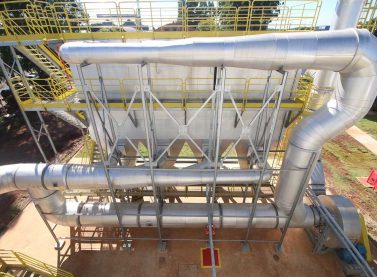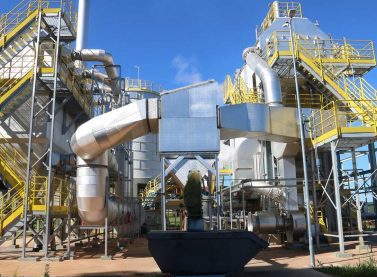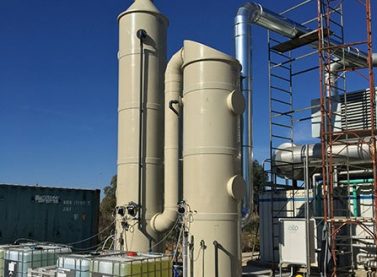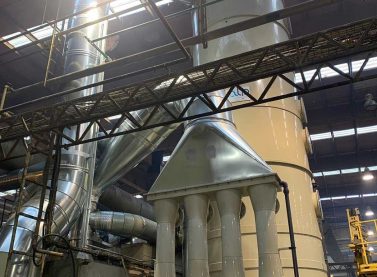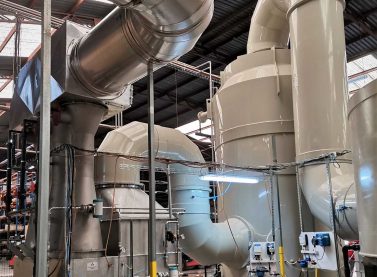Systems for the treatment of particulate emissions
We design and supply systems for the treatment of emissions with dust and particulate matter. To achieve this, we have various technologies that include wet systems, such as scrubbers, and dry systems, such as fabric filter baghouses or cyclones.
Particulate matter is not a single contaminant, but a complex mixture of different chemical components, including solids and aerosols made up of small liquid droplets, fragments of dry solids, and solid nuclei with liquid coatings.
We offer customized solutions that adapt to the needs and objectives of each client, optimizing operational efficiency and project profitability, while ensuring compliance with rigorous environmental regulations.
We provide comprehensive services, ranging from initial consulting to the implementation of the treatment system and its continuous maintenance.
Technologies for particulate matter removal
We supply various technologies for treating emissions with dust and particulate matter generated in industrial processes. These technologies aim to capture, reduce, or eliminate solid particles suspended in the air before they are released into the environment.
The choice of technology depends on variables such as the type and size of particles, moisture content, particle size distribution, emission volume, nature of the industry, and applicable environmental regulations.
It is important to highlight that emission control requirements are becoming increasingly stringent and have a significant influence on the design of dust or aerosol-contaminated emission treatment systems.
Dedusting, or the removal of dust and/or aerosols, can be carried out using both dry and wet methods.
Wet Systems
Gas scrubbers use liquids (such as water or chemical solutions) to capture and remove particles. The contaminated air passes through the liquid, where the particles adhere to the liquid and are then removed through sedimentation or filtration processes.
Different types of scrubbers offer high efficiency for particle and dust removal:
- Plate perforated gas scrubbers.
- Venturi scrubbers.
Special packing scrubbers.
Dry Systems
Different dry technologies or systems exist for treating emissions with dust and particles:
- Fabric filter baghouses, also known as bag filters or fabric filters, are systems that use fabric bags to capture suspended particles in the air. Contaminated air passes through the bags, and particles become trapped on the surface. The filter is periodically agitated or compressed air is applied to dislodge accumulated particles, which are collected in a container. These types of filters can achieve collection efficiencies of over 99% for very fine particles (submicron).
- Cyclones are devices that use centrifugal force to separate heavier particles from the airflow. The particles are directed towards the cyclone walls and then fall into a collection container, while clean air exits from the top. The ability to treat particles of varying sizes depends on the cyclone diameter. Cyclones ensure high efficiency for particles larger than 10 micrometers.
- Absolute filters have a large filtration area, ensuring high air filtration efficiency and significant dust retention capacity. They can separate fine particles from the air using filtering cartridges with single or double F-class pre-reduction filtration and absolute H-class filtration coils.
- Advanced filtration technologies that capture particles present in emissions. These may include ceramic filters, membranes, and other materials with selective capture properties.
- Electrostatic precipitators use electric fields to charge particles and then attract them to oppositely charged plates, where they accumulate and can be removed. Electrostatic precipitators are effective for capturing fine particles and are used in various industries.
Technologies for particulate matter removal
Dust and particulate emissions
The air contains a diverse mixture of microscopic particles, which can originate naturally but also arise from various industrial processes or electricity generation. Particulate emissions refer to the release of these small solid particles into the air as a result of various industrial activities.
Exposure to dust and particulate emissions can have adverse impacts on human health, contributing to respiratory diseases and cardiovascular issues. Additionally, these particles can also have negative effects on the environment, contributing to smog formation, reducing visibility, and affecting air quality and ecosystems.
These particles can have different sizes and compositions, and they are generally divided into two categories based on their aerodynamic diameter:
- PM10: Particles with a diameter of 10 micrometers (µm) or smaller. These particles are small enough to be deeply inhaled into the lungs and can cause respiratory and general health problems.
- PM2.5: Particles with a diameter of 2.5 micrometers (µm) or smaller. These particles are even smaller and can penetrate further into the respiratory system and even reach the bloodstream, increasing the risk of cardiovascular problems and other negative health effects.
Industries and applications
Dust and particulate emissions are generated from a variety of sources and human activities, as well as natural processes. Some notable sources include:
- Industrial activities such as paper and pulp production, woodworking and furniture, textiles, food, chemical and pharmaceutical production, mining, ceramics, each involving different processes that generate dust and particles.
- Metal smelting and power generation from coal combustion can release particles and fumes into the air as byproducts.
- Agricultural activities such as plowing, harvesting, and burning agricultural residues can release dust and particles into the air. Additionally, the use of fertilizers and agricultural chemicals also contributes to particle generation.
- Burning wood, charcoal, and other organic materials releases particles into the air.
- Construction and demolition processes, including the use of heavy machinery, demolition of structures, and handling construction materials, can release dust and particles into the environment.
